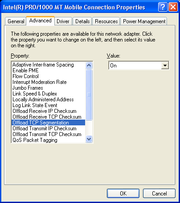
TCP segmentation offloading
Encyclopedia

Computer network
A computer network, often simply referred to as a network, is a collection of hardware components and computers interconnected by communication channels that allow sharing of resources and information....
ing, large segment offload (LSO) is a technique for increasing outbound throughput
Throughput
In communication networks, such as Ethernet or packet radio, throughput or network throughput is the average rate of successful message delivery over a communication channel. This data may be delivered over a physical or logical link, or pass through a certain network node...
of high-bandwidth
Bandwidth (computing)
In computer networking and computer science, bandwidth, network bandwidth, data bandwidth, or digital bandwidth is a measure of available or consumed data communication resources expressed in bits/second or multiples of it .Note that in textbooks on wireless communications, modem data transmission,...
network connections by reducing CPU
Central processing unit
The central processing unit is the portion of a computer system that carries out the instructions of a computer program, to perform the basic arithmetical, logical, and input/output operations of the system. The CPU plays a role somewhat analogous to the brain in the computer. The term has been in...
overhead. It works by queuing up large buffer
Buffer (computer science)
In computer science, a buffer is a region of a physical memory storage used to temporarily hold data while it is being moved from one place to another. Typically, the data is stored in a buffer as it is retrieved from an input device or just before it is sent to an output device...
s and letting the network interface card (NIC) split them into separate packets. The technique is also called TCP segmentation offload (TSO) when applied to TCP
Transmission Control Protocol
The Transmission Control Protocol is one of the core protocols of the Internet Protocol Suite. TCP is one of the two original components of the suite, complementing the Internet Protocol , and therefore the entire suite is commonly referred to as TCP/IP...
, or generic segmentation offload (GSO).
Operation
When large chunks of data are to be sent over a computer network, they need to be first broken down to smaller segments that can pass through all the network elements like routers and switches between the source and destination computers. This process is referred to as segmentationPacket segmentation
In a data communications networks, packet segmentation is the process of dividing a data packet into smaller units for transmission over the network...
. Segmentation is often done by the TCP protocol in the host computer. Offloading this work to the NIC is called TCP segmentation offload (TSO).
For example, a unit of 64KB (65,536 bytes) of data is usually segmented to 46 segments of 1448 bytes each before it is sent over the network through the NIC. With some intelligence in the NIC, the host CPU can hand over the 64 KB of data to the NIC in a single transmit request, the NIC can break that data down into smaller segments of 1448 bytes, add the TCP, IP
Internet Protocol
The Internet Protocol is the principal communications protocol used for relaying datagrams across an internetwork using the Internet Protocol Suite...
, and data link layer protocol headers -- according to a template provided by the host's TCP/IP stack -- to each segment, and send the resulting frames over the network. This significantly reduces the work done by the CPU. Many new NICs on the market today support TSO.
Some network cards implement TSO generically enough that it can be used for offloading fragmentation of other transport layer
Transport layer
In computer networking, the transport layer or layer 4 provides end-to-end communication services for applications within a layered architecture of network components and protocols...
protocols, or by doing IP fragmentation
IP fragmentation
The Internet Protocol implements datagram fragmentation, so that packets may be formed that can pass through a link with a smaller maximum transmission unit than the original datagram size....
for protocols that don't support fragmentation by themselves, such as UDP
User Datagram Protocol
The User Datagram Protocol is one of the core members of the Internet Protocol Suite, the set of network protocols used for the Internet. With UDP, computer applications can send messages, in this case referred to as datagrams, to other hosts on an Internet Protocol network without requiring...
.

